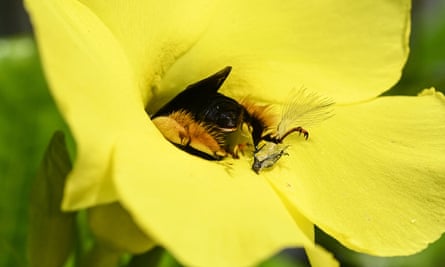A small girl is eating ice cream. She is at a lake, “Zoo Lake”, in the middle of a city. People who live nearby hear the Zoo’s lions roaring at night. (A world and a century away, in Innisfree, Yeats lives “alone in the bee-loud glade”.)
The principal activities at this lake are learning to ride bikes, riding bikes, and walking. Ice-cream sellers pedal their cooler boxes round and round the water. Bees hover over the rubbish bins full of ice-cream wrappers.
The girl has stopped eating her Zooty Fruit because a bee has landed on her mouth. It walks, vibrating, around the edge of her lips, drinking the melted syrup. Then it takes flight. And the girl leaves with her family. They leave because they know – because the father tells them – that the bee will soon be back “with all its friends”.
The bee arrives at the hive and crawls in. Maybe it is a young bee. It starts dancing with all its might, swearing on its life: “Guys, guys, I swear, come with me. I found a good spot, I swear.”
In a slow-motion black-and-white video, the paper wasp is preparing to sting. It is held by tweezers. Its body bends backwards in a way that only an insect’s could, in an uncanny, creepy way that lets you know the wasp’s friends are the scorpion and the centipede.
Held by another set of tweezers, the honey bee’s behaviour is completely different (is this not the fundamental thing about the bee’s nature: that it is not a wasp). Consider: the bee flails all its legs as though its body is falling through the air – this is what it feels like for a bee to be suspended, but not in flight. It moves its head side to side like a puppy. It seems worried.
When the wasp is made to sting a piece of clear silicone, it does so with its head bowed just slightly, as though a medical procedure is being performed on part of its body and it is breathing through the discomfort. In goes the sting, and the wasp seems to relax.
The bee hunches over, lowering its head to the silicone. Its mouth opens and closes, kissing the ground. This is its final gesture before it dies. Inside its body, the two glands in its venom sac are releasing liquids that, alone, are not harmful. When mixed they are toxic. The sting’s hooked teeth ensures that once inserted it cannot be pulled out – but the bee tries, and the organ rips from its body, taking some intestine with it.

A bee also has a heart, but it cannot have a heart attack. It makes bee “bread” – fermented pollen – and honey, and to complete its breakfast, it sometimes drinks nectar from caffeinated plants. When it does this, its memory improves. The bee’s favourite thing to do is to crawl inside a flower, where petals turn the light pink or yellow or red.
Their wings are clear, their feelers ever-waving. Their back legs, when dressed in fluffy pollen trousers: heartbreaking.
“The Nature of … ” is a column by Helen Sullivan dedicated to interesting animals, insects, plants and natural phenomena. Is there an intriguing creature or particularly lively plant you think would delight our readers? Let us know on Twitter @helenrsullivan or via email: helen.sullivan@theguardian.com

